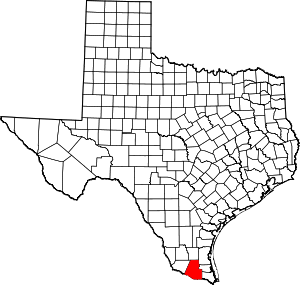McAllen, Texas
McAllen is the largest city in Hidalgo County, Texas, United States, and the 22nd-most populous city in Texas. It is located at the southern tip of the state in the Rio Grande Valley, close to the country of Mexico. The city limits extend south to the Rio Grande, across from the Mexican city of Reynosa. McAllen is about 70 mi (110 km) west of the Gulf of Mexico. As of 2019, McAllen's population was estimated to be 143,268.[2] It is the fifth-most populous metropolitan area (McAllen–Edinburg–Mission) in the state of Texas, and the binational Reynosa–McAllen metropolitan area counts a population of nearly 1.52 million.[5]
McAllen, Texas | |
|---|---|
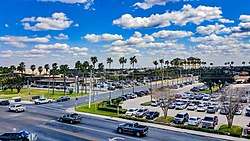 | |
| Nickname(s): "The City of Palms" | |
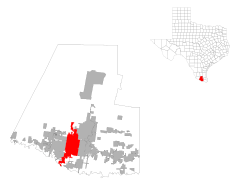 Location within Hidalgo County | |
 McAllen Location within Texas  McAllen Location within the United States | |
| Coordinates: 26°12′59″N 98°14′11″W | |
| Country | |
| State | |
| County | |
| Government | |
| • Type | Council-Manager |
| • City Council | Mayor Jim Darling Javier Villalobos (District 1) Joaquin J. Zamora (District 2) Julian Omar Quintanilla (District 3) Tania Ramirez (District 4) Victor Sebastian Haddad (District 5) Veronica Whitacre (District 6) |
| • City Manager | Roel "Roy" Rodriguez |
| • Texas State Representative | Robert Guerra |
| • Texas State Senator | Juan Hinojosa |
| • U.S. Representative | Vicente Gonzalez |
| Area | |
| • City | 62.73 sq mi (162.48 km2) |
| • Land | 62.31 sq mi (161.37 km2) |
| • Water | 0.43 sq mi (1.11 km2) |
| Elevation | 121.4 ft (37.1 m) |
| Population (2010) | |
| • City | 129,877 |
| • Estimate (2019)[2] | 143,268 |
| • Density | 2,299.43/sq mi (887.81/km2) |
| • Metro | 774,769 |
| Time zone | UTC−6 (CST) |
| • Summer (DST) | UTC−5 (CDT) |
| ZIP Codes | 78501–78504 |
| Area code(s) | 956 |
| FIPS code | 48-45384[3] |
| GNIS feature ID | 1374829[4] |
| Website | www |
From its settlement in 1904, the area around McAllen was largely rural and agricultural in character, but the latter half of the 20th century had steady growth, which has continued in the 21st century in the metropolitan area. The introduction of the maquiladora economy and the North American Free Trade Association led to an increase in cross-border trading with Mexico.[6]
History
In 1904, the Hidalgo and San Miguel Extension (now the Sam Fordyce Branch) of the St. Louis, Brownsville and Mexico Railway reached the Santa Anita Ranch. John McAllen and his son James had donated land to the railroad to guarantee it would cross this area. On December 5, 1904, the McAllen Townsite Company was formed by Uriah Lott, Leonidas C. Hill Sr., John McAllen, James Ballí McAllen, and John J. Young. The new community, which was named for John McAllen, had the depot nearest the county seat, Hidalgo, 8 mi (13 km) to the south.
By 1911, 5,000 acres (2,000 ha) were under cultivation in East McAllen: commodity crops of cotton, alfalfa, broom corn, citrus fruits, grapes, and figs were raised. East McAllen had an estimated population of 1,000 that year, and West McAllen had ceased to exist. In 1911, the town applied for and was issued a charter of incorporation under the name McAllen. In 1916, 20,000 New York state troops were stationed at McAllen to help quell border disturbances related to the Mexican Civil War. The resulting economic boom increased the population from 1,200 in 1916 to 6,000 in 1920.[7]
McAllen adopted a home rule charter in 1927. Canning factories, a winery, tortilla plants, wood-working plants, and some oil exploration increased the population to 9,074 by 1930. In 1936, Hiram Garner opened the Valley Distillery, Incorporated, which produced wines from citrus juices. The town was a petroleum and farm chemurgic center with a population of 11,877 in 1940, by which time it had adopted the nickname "The City of Palms". In 1941, a suspension bridge replaced the old bridge from Hidalgo to Reynosa in Tamaulipas; the new toll bridge was purchased by McAllen and was named the McAllen–Hidalgo–Reynosa International Bridge. Its construction resulted in increased tourist trade, making McAllen a winter resort and port of entry to Mexico.
The discovery of oil in the Reynosa area in 1947 attracted a large migration of people from the Mexican interior to jobs the region. They both constituted a new tourist market and a cheap labor supply for McAllen. The sister cities were linked as a result of the increased traffic between them. The population of McAllen was 20,005 in 1950 and 32,728 in 1960. In 1954 the McAllen–Hidalgo–Reynosa International Bridge was the number-two port of entry into Mexico.[8]
McAllen was an agricultural, oil, and tourist center in 1970, when the population reached 37,636. By the start of the 1970s, McAllen had a 200-bed hospital and a new air-conditioned high school, the first school in the nation featuring on-site power generated by natural gas-powered turbines. The tourism industry continued to expand as people traveled to the area from both Mexico and the northern United States. The population continued to grow steadily through the 1970s, and reached 66,281 by 1980. During the late 1980s, the McAllen Foreign Trade Zone was an important general-purpose foreign trade zone.[9] At the time, McAllen's main industries were retail, tourism and farming, and each was in trouble. The devaluation of the Mexican peso in the 1980s put a damper on cross-border shopping; local tourism was down because of the recession. In 1983, a freeze took out much of the valley's citrus crop.
In the mid-1980s, fueled by trade and the growth of the maquiladora (in which components are shipped to Mexico from the United States, assembled, and shipped back as finished products), the economy began to improve in Hidalgo County. McAllen sits across the border from Reynosa, a large manufacturing center. After the peso devalued, Mexico was more successful in attracting companies to run their plants in Mexico, with support operations in Texas.
Border crossing is a daily event for many and is a key component in the local economy.[10] The city became a focal point for concerns about the border during the United States federal government shutdown of 2018–2019 over the Mexico–United States barrier. President Trump held a briefing with the border agents at the patrol station here in January 2019.[11] Homeland Security Secretary Kirstjen Nielsen also visited the Border Patrol station in March 2019. In order to deal with overcrowded facilities in 2019 resulting from the arrival of Central American migrant caravans, immigration authorities were releasing a few hundred asylum seekers daily to private groups that assist them with basic needs and travel arrangements.[12]
The mayor emphasized how safe and secure the city is when U.S military troops were mobilized here to help the Border Patrol.[13] Portions of the razor wire coils considered unnecessary by the city were removed after troops had placed it at the border.[13] The troops assisted by using military helicopters to carry border patrol agents to and from locations along the Mexico–United States border and by maintaining vehicles.[10] During these border support activities, they are prohibited from law enforcement activities, such as detaining migrants or seizing drugs.[10] U.S. military troops are prohibited from carrying out law enforcement duties.[14] The Marine Corps Commandant General Robert Neller expressed concerns about the impact of continuing border support on combat readiness for the troops.[10]
Geography
McAllen is located in southern Hidalgo County at 26°12′59″N 98°14′11″W (26.216263, −98.236385).[15] It is bordered to the southwest by Granjeno; to the west by Mission, Palmhurst, and Alton; to the north by Edinburg, the Hidalgo county seat; to the east by Pharr; and to the south by Hidalgo. The McAllen city limits extend to the southwest as far as the Rio Grande, directly north of Reynosa, Tamaulipas, in Mexico. The Anzalduas International Bridge crosses the Rio Grande at this point, 11 mi (18 km) southwest of downtown McAllen.
McAllen is 238 mi (383 km) south of San Antonio, 148 mi (238 km) southeast of Laredo, 60 mi (97 km) northwest of Brownsville, and 150 mi (240 km) northeast of Monterrey.
According to the United States Census Bureau, the city has a total area of 48.6 square miles (126.0 km2), of which 48.3 square miles (125.2 km2) are land and 0.3 square miles (0.8 km2), or 0.62%, is covered by water.[16]
Although McAllen is named the "City of Palms", tropical vegetation is only locally dominant. Many thorny shrubs and deciduous trees occur in the area, such as the Rio Grande ash (Fraxinus berlandieriana), cedar elm (Ulmus crassifolia), and honey mesquite (Prosopis glandulosa).
Climate
McAllen, like much of South Texas, has a subtropical climate.[17] Under the Köppen climate classification, the city features a hot semiarid climate, featuring long, very hot and humid summers, and brief, warm winters. The city has two distinct seasons; a wet season from May to October and a dry season from November to April. The normal monthly mean temperature ranges from 60.8 °F (16.0 °C) in January to 87.4 °F (30.8 °C) in August.[18] The warm season is extremely long, as average high temperatures from May through September are above 90 °F (32 °C) and average low temperatures are above 70 °F (21 °C), with relatively high dew point values, resulting in higher relative humidity values and heat index values. Heat indices consistently reach over 110 °F (43 °C) during these months.
Average annual precipitation is 22.20 inches (564 millimeters). Most precipitation occurs in the warm season, with the least precipitation distinctly occurring in the cooler winter. As September is the peak of the north Atlantic hurricane season and tropical storms and hurricanes occasionally drop copious amounts of rainfall on the region, this month tends by far to be the wettest, averaging 4.47 in (114 mm) of rain. The driest month is November, with only 0.89 in (23 mm) of precipitation. Since 1941, it has snowed once, when the city received 1.7 in (43 mm) on December 25, 2004.[18]
Temperatures consistently rise above 100 °F (38 °C) from June through August, with exceptionally high humidity. The highest temperature ever recorded in McAllen was 111 °F (44 °C), set on June 22, 2017. The lowest temperature ever recorded in McAllen was 13 °F (−11 °C), on January 12, 1962.[18]
| Climate data for McAllen, Texas (McAllen Miller Int'l Airport), 1981–2010 normals,[lower-alpha 1] extremes 1941–present | |||||||||||||
|---|---|---|---|---|---|---|---|---|---|---|---|---|---|
| Month | Jan | Feb | Mar | Apr | May | Jun | Jul | Aug | Sep | Oct | Nov | Dec | Year |
| Record high °F (°C) | 96 (36) |
101 (38) |
105 (41) |
107 (42) |
110 (43) |
111 (44) |
109 (43) |
108 (42) |
108 (42) |
104 (40) |
102 (39) |
96 (36) |
111 (44) |
| Mean maximum °F (°C) | 86.5 (30.3) |
91.8 (33.2) |
95.7 (35.4) |
99.2 (37.3) |
99.3 (37.4) |
101.3 (38.5) |
102.6 (39.2) |
103.4 (39.7) |
100.3 (37.9) |
96.4 (35.8) |
91.8 (33.2) |
87.6 (30.9) |
104.8 (40.4) |
| Average high °F (°C) | 71.0 (21.7) |
75.1 (23.9) |
81.8 (27.7) |
87.1 (30.6) |
91.7 (33.2) |
96.2 (35.7) |
97.1 (36.2) |
98.1 (36.7) |
93.1 (33.9) |
87.6 (30.9) |
79.9 (26.6) |
72.0 (22.2) |
85.9 (29.9) |
| Average low °F (°C) | 50.7 (10.4) |
54.2 (12.3) |
59.8 (15.4) |
66.0 (18.9) |
72.1 (22.3) |
75.7 (24.3) |
76.4 (24.7) |
76.7 (24.8) |
73.4 (23.0) |
66.8 (19.3) |
58.9 (14.9) |
51.9 (11.1) |
65.3 (18.5) |
| Mean minimum °F (°C) | 35.3 (1.8) |
37.6 (3.1) |
42.6 (5.9) |
50.8 (10.4) |
61.6 (16.4) |
69.5 (20.8) |
72.5 (22.5) |
72.7 (22.6) |
63.1 (17.3) |
50.8 (10.4) |
42.5 (5.8) |
34.8 (1.6) |
31.5 (−0.3) |
| Record low °F (°C) | 13 (−11) |
19 (−7) |
31 (−1) |
40 (4) |
50 (10) |
59 (15) |
65 (18) |
64 (18) |
50 (10) |
41 (5) |
30 (−1) |
18 (−8) |
13 (−11) |
| Average precipitation inches (mm) | 1.05 (27) |
1.11 (28) |
1.03 (26) |
1.34 (34) |
2.25 (57) |
2.58 (66) |
2.00 (51) |
2.21 (56) |
4.47 (114) |
2.08 (53) |
0.89 (23) |
1.19 (30) |
22.20 (564) |
| Average precipitation days (≥ 0.01 in) | 7.4 | 5.4 | 4.0 | 4.2 | 4.8 | 5.4 | 5.5 | 5.4 | 7.5 | 5.6 | 4.1 | 5.9 | 65.2 |
| Source: NOAA[18][19] | |||||||||||||
Demographics
| Historical population | |||
|---|---|---|---|
| Census | Pop. | %± | |
| 1910 | 150 | — | |
| 1920 | 5,331 | 3,454.0% | |
| 1930 | 9,074 | 70.2% | |
| 1940 | 11,877 | 30.9% | |
| 1950 | 20,067 | 69.0% | |
| 1960 | 32,728 | 63.1% | |
| 1970 | 37,636 | 15.0% | |
| 1980 | 66,281 | 76.1% | |
| 1990 | 89,000 | 34.3% | |
| 2000 | 106,414 | 19.6% | |
| 2010 | 129,877 | 22.0% | |
| Est. 2019 | 143,268 | [2] | 10.3% |
| U.S. Decennial Census[20] | |||
As of the census[3] of 2010, 129,877 people, 41,573 households, and 31,823 families resided in the city. Of the 45,862 housing units, 4,289, or 9.4%, were vacant.[21]
The racial makeup of the city was 83.9% White, 0.9% African American, 0.4% Native American, 2.6% Asian, 0.02% Pacific Islander, 10.4% some other race, and 1.8% from two or more races. Hispanics or Latinos of any race were 84.6% of the population.[21]
Of the 41,573 households, 46.0% had children under the age of 18 living with them, 52.2% were married couples living together, 19.0% had a female householder with no husband present, and 23.5% were not families. About 19.1% of all households were made up of individuals, and 23.9% were someone living alone who was 65 years of age or older. The average household size was 3.10, and the average family size was 3.58.[21]
In the city, the population was distributed as 30.1% under the age of 18, 9.6% from 18 to 24, 28.1% from 25 to 44, 21.3% from 45 to 64, and 10.9% 65 years of age or older. The median age was 32.2 years. For every 100 females, there were 91.5 males. For every 100 females age 18 and over, there were 87.2 males.[21]
For the period 2012–2016, the estimated median annual income for a household in the city was $45,568, and for a family was $50,184. The per capita income for the city was $21,726. About 22.5% of families and 25.7% of the entire population were below the poverty line, including 36.6% of those under age 18 and 21.4% of those age 65 or over.[22]
Crime
Based on the Texas Department of Public Safety's Annual Crime in Texas report and the FBI's Crime in the United States report, there were zero (0) murders reported during 2018.[23] The city has been consistently ranked among the safest cities in Texas.[24]
Health
McAllen was the focus of a 2009 article in The New Yorker by Atul Gawande entitled "The Cost Conundrum", an inquiry into the factors that contribute to the cost of health care. The McAllen area had the highest taxpayer-sponsored spending per beneficiary in the United States, despite areas with similar demographics and health profiles having half the cost per recipient. The article noted that while the area has a higher prevalence of obesity and diabetes, its rates of infant mortality, HIV, and tobacco use were lower than the national average.[25]
McAllen was the most obese metropolitan area in the country in 2012, with 38.5% of the adult population considered obese. The high obesity rate has likely contributed to area residents' poor health. More than 21% of the population has been diagnosed with diabetes, more than any other metro area in the United States. Poverty may play a large role in the community's health problems, as well. Over 25% of the city population was living below the poverty line during the period 2012–2016.[22] More than 29% of the population also lacked health coverage during that time.[22]
McAllen is featured in Supersize vs Superskinny,[26] a British television programme on Channel 4 that features information about dieting and extreme eating lifestyles. One of the main show features is a weekly comparison between an overweight person and an underweight person. In the show, the overweight participant visits morbidly obese McAllen residents to find motivation for lifestyle and diet changes.
Economy
The Rio Grande Valley began its rapid development with the introduction of irrigation in 1898 and the construction of the railroad in 1904. These major additions turned a once relatively desolate area into a major agricultural center. Throughout much of the 1900s, McAllen was a rural, agriculture-based economy characterized by sporadic growth.
Today, the area is transforming into a major international trade area. As recently as 1990, McAllen's unemployment rate was at 22.6%. By the end of 2005, that figure had dropped to 7.7%. However, in 2011, census.gov listed the McAllen metro area the poorest in the nation.[27] As of 2012, the average cost of a home in McAllen was the third-least expensive in the country, at $178,000, while average monthly rent for a two-bedroom apartment was $708. In 2012, the cost of living in McAllen was 16.2% lower than the national average.[28]
Trade
Since the 1980s and especially since the ratification of the North American Free Trade Agreement in 1994, the focal point of economic activity has shifted from agriculture to international trade, health care, retail, and tourism.
The McAllen Foreign-Trade Zone (FTZ) is located south of McAllen between McAllen and Reynosa. Commissioned in 1973, it was the first inland foreign-trade zone in the United States. Also, an FTZ designation site is at the McAllen Miller International Airport to facilitate air cargo needs. Under U.S. and Mexican laws and NAFTA provisions, the FTZ designation offers specific cost-saving opportunities to manufacturers. Products can be brought into the FTZ duty-free. Services have recently expanded to include full logistic support services, including public warehouse services such as pick and pack, order processing, inventory control, incoming/outgoing quality inspection, and kitting.[29]
Sports
Dynamo South Texas Academy is a soccer development academy created in 2007 by the Houston Dynamo of Major League Soccer. The Dynamo announced the creation of the Dynamo South Texas Academy as the franchise's first satellite academy. The Dynamo and the McAllen Youth Soccer Association partner to develop young talent in the Rio Grande Valley region of South Texas. They have DSTA's U-18 and U-15 teams, which train and compete in several South Texas cities, including McAllen, Harlingen and Brownsville.[30]
McAllen hosted the NAIA National Football Championship in the late 1970s and NCAA Division II national football championship games in the 1980s.
Until 2014, McAllen was home to the Texas Thunder of the independent United League Baseball, who played at Edinburg Stadium.
Recreation
Birdwatching – McAllen is positioned on a major flyway, the migratory path of birds between North and South America, presenting opportunities for bird and butterfly expeditions. The landscape hosts a diverse wildlife population. The Quinta Mazatlan, a historic Spanish colonial mansion, is used as McAllen's wing of the World Birding Center.[31]
The Bicentennial Bike Path runs from Highway 83 on the south side to Bicentennial and Trenton Road on the north side. The International Museum of Art & Science,[32] Smithsonian affiliate and AAM-accredited museum founded in 1967, is located near the path at the corner of Bicentennial and Nolana Avenue.
The Zinnia Spray Water Park is McAllen's first sprayground park. It is located at 29th and Zinnia Ave.[33]
Palm View Golf Course is located on South Ware Road just south of Highway 83. The golf course has 18 holes plus a driving range. This course hosts numerous tournaments year round.[34]
Dog owners have room to run their pets at the McAllen Dog Park, which is divided into two sections.
Government
- Frank W. Crow, 1911-1913[35][36]
- O. P. Archer, 1913-1923
- F.B. Freeland, 1923-1929
- Frank E. Osborn, 1929-1931
- John Ewing, 1931-1934
- A.L. Landry, 1935-1937
- Horace Etchison, 1937-1944
- Dr. Frank Osborn, 1944-1945
- Allen F. Vannoy, 1945-1947
- T. B. Waite, Jr., 1947-1948
- C. W. Davis, 1949-1952
- Angus McLeod, 1952-1953
- Phillip Boeye, 1953-1961
- Robert F. Barnes, 1961-1963
- Paul G. Veale, 1963-1969
- Jack Whetsel, 1969-1977
- Othal E. Brand, 1977-1981
- Othal E. Brand Sr., 1981-1997
- Leo Montalvo, 1997-2005
- Richard F. Cortez, 2005-2013
- James E. Darling, 2013–Present
The Texas Department of Criminal Justice operates an office in McAllen.[37]
Federal representation
The United States District Court for the Southern District of Texas McAllen Division is located at Bentsen Tower 1701 W. Hwy. 83, Suite 1011, McAllen, Texas.
The United States Postal Service operates two post offices in McAllen: McAllen Post Office, located at 620 Pecan Blvd, and the McAllen Downtown Post Office at 406 12th Street.[38][39]
The United States Border Patrol McAllen Station is located at 3000 West Military Highway.
The United States Border Patrol Central Processing Center is located at 3700 W Ursula Avenue, McAllen, Texas.[40][41]
The 2LT Luis G. Garcia United States Army Reserve Center located at 600 S Col Rowe Blvd is home for the United States Army Reserve 961st Quartermaster Company, 461st Transportation Detachment, and 519th Transportation Detachment.
McAllen is represented in the United States House of Representatives by two Democrats: Vicente Gonzalez of the 15th Congressional District, and Henry Cuellar of the 28th Congressional District.
Transportation
Mass transit
Metro McAllen (formerly McAllen Express Transit - MET) has provided public transportation for the city of McAllen since June 1997. In the beginning, McAllen Express was administered by the Lower Rio Grande Valley Development Council. Since 2005, Metro McAllen has been operated as a department of the city of McAllen. Metro McAllen now has nine fixed routes and paratransit, serving residents and visitors. It operates seven days a week, from 6am-9pm Monday through Saturday and from 8am-6pm on Sunday. LRGVDC continues to operate regional buses under the name Valley Metro.
MET Fare structure
| Adults | Students | Elderly |
|---|---|---|
| $1.00 | $0.50 | $0.50 |
- Website: metromcallen.com
- Customer Service: (956) 681-3510
- Bus Tracker: cityofmcallen.ridesystems.net
- Downtown bus terminal
The City of McAllen also operates the bus terminal facility in downtown McAllen, known as McAllen Central Station. Central Station serves as a hub for MET and for 14 private domestic and international bus lines. Around 60 buses depart from Central Station on a daily basis. It is centrally located in downtown McAllen at 1501 W Hwy 83.
Highways





Airports
- McAllen Miller International Airport[42] is served by American Airlines with non-stop service to Dallas/Fort Worth; by United with non-stop service to Houston; by Aeromar with nonstop service to Mexico City; and by Allegiant Air with nonstop flights to Las Vegas and with seasonal service to Los Angeles and Orlando-Sanford.
Education
Postsecondary
- South Texas College has a total of more than 27,000 students attending its five campuses in Hidalgo and Starr counties, and the eSTC virtual campus. The main campus is in McAllen.
Primary and secondary schools

The McAllen Independent School District serves most of the city. Portions of the city extend into the Edinburg Consolidated Independent School District, which operates two elementary schools within the McAllen city limits. The Hidalgo Independent School District, Pharr-San Juan-Alamo Independent School District, Sharyland Independent School District, and Valley View Independent School District also serve McAllen.
In addition, residents are allowed to apply to magnet schools operated by the South Texas Independent School District.
The Catholic Diocese of Brownsville operates Our Lady of Sorrows School, an elementary and middle school.
Public libraries
McAllen Public Library operates a main library and two branches, the Lark Branch and the Palm View Branch. The New Main Library opened in the fall of 2011 inside a former Walmart big box store.[43] The library earned high praise and received the International Interior Design Association's 2012 Library Interior Design Award.[44]
Arts and culture
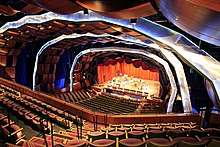
International Museum of Art & Science (IMAS), founded in 1967, is a Smithsonian Affiliate and American Alliance of Museums (AAM) accredited museum located in McAllen at the corner of Bicentennial and Nolana Avenue.
Media and journalism
Television stations
- XHRIO-TV 2 Matamoros, Tamaulipas The CW
- KGBT-TV 4 Harlingen, Texas Independent
- KRGV-TV 5 Weslaco, Texas ABC
- XHAB-TV 7 Matamoros, Tamaulipas Vallevision
- XERV-TV 9 Reynosa, Tamaulipas Canal de las Estrellas
- XHREY-TV 12 Reynosa, Tamaulipas Azteca 13
- XHOR-TV 14 Reynosa, Tamaulipas Azteca 7
- KVEO 23 Brownsville, Texas NBC/CBS
- KTFV-CD 32 McAllen, Texas UniMás
- KTLM 40 Rio Grande City, Texas Telemundo
- KNVO 48 McAllen, Texas Univision
- XHVTV-TV 54 Reynosa, Tamaulipas Multimedios
- KMBH 60 Harlingen, Texas PBS
- KFXV-LD 67 McAllen, Texas FOX
- [ MCN ] 17.12 McAllen, Texas Public Broadcasting Station
Radio stations
- KURV 710 AM News Talk Radio
- XERDO-AM La Raza 1060 AM (Regional Mexican) [Spanish]
- XEMS-AM Radio Mexicana 1490 AM (Regional Mexican) [Spanish]
- KHID 88.1 FM McAllen (National Public Radio)
- XHRYS-FM Hits FM 90.1 FM (Top 40 Hits) [Spanish]
- XHRYN-FM Uni 90.5 FM [Spanish]
- XHRYA-FM Mas Musica 90.9 FM (Hit Radio) [Spanish]
- XHMLS-FM Exitos 91.3 FM (All-Time Hits) [Spanish]
- KCAS The New KCAS 91.5 FM
- XHEOQ-FM Notigape 91.7 FM (News) [Spanish]
- XHAAA-FM La Caliente 93.1 FM (Regional Mexican) [Spanish]
- KFRQ Q94.5 FM (Classic/Modern/Hard Rock)
- XHRT-FM Xtrema 95.3 FM (All-Time Hits) [Spanish]
- KBTQ Recuerdo 96.1 FM (Oldies) [Spanish]
- KVMV Family Friendly & Commercial Free 96.9 FM (Adult Contemporary Christian)
- KGBT-FM Solamente Exitos 98.5 FM (Regional Mexican) [Spanish]
- KKPS La Nueva 99.5 FM (Local Tejano Music) [Spanish]
- KTEX South Texas Country 100.3 FM (Country)
- KNVO-FM Jose 101.1 FM [Spanish]
- XHAVO-FM Digital 101.5 FM (International Music) [Spanish]
- KBFM Wild 104.1 FM (Hip-Hop/R&B/Reggaeton)
- KJAV 104.9 FM Ultra 104.9 ("Sonamos Diferente")(Classic Hits)
- KQXX The X 105.5 FM (Classic rock)
- KHKZ Kiss 106.3 FM (Hot AC)
- XHVTH-FM La Mas Buena 107.1 FM (Regional Mexican) (in Spanish)
- KVLY Mix 107.9 FM (Top 40)
Area newspapers
- The Monitor
- Valley Morning Star
- Texas Border Business
- Mega Doctor News
Architecture and points of interest
- Tallest buildings
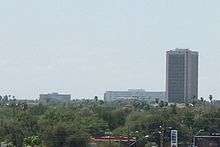
| Rank | Building | Height |
|---|---|---|
| 1 | Chase Neuhaus Tower | 17 Floors |
| 2 | BBVA Compass Tower | 11 Floors |
| 3 | Bentsen Tower | 11 Floors |
| 4 | DoubleTree Suites by Hilton Hotel | 9 Floors |
| 5 | McAllen Medical Center | 8 Floors |
| 6 | Inter National Bank | 6 Floors |
- Districts
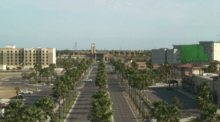
- Downtown McAllen
- De Palmas Historic District
- 17 Street Entertainment District
- McAllen Arts District
- Uptown McAllen
- McAllen Convention Center District
- Points of Interest
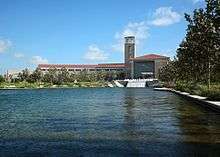
- McAllen Botanical Gardens
- Quinta Mazatlan[45]
- McAllen Convention Center
- La Plaza Mall
- International Museum of Art and Science
- Historic Cine El Rey Theatre
Notable people
- Abraham Ancer, professional golfer, born in McAllen
- Jorge Cantú, baseball player, born in McAllen in 1982
- Raúl Castillo, actor, born in McAllen in 1977
- Henry Cuesta, clarinetist on The Lawrence Welk Show, born in McAllen in 1931
- Ana Brenda Contreras, Mexican American actress and singer, born in McAllen on December 24, 1986
- Sons of Texas, heavy metal band
See also
Notes
Footnotes
- Mean monthly maxima and minima (i.e. the highest and lowest temperature readings during an entire month or year) calculated based on data at said location from 1981 to 2010.
Citations
- "2019 U.S. Gazetteer Files". United States Census Bureau. Retrieved August 7, 2020.
- "Population and Housing Unit Estimates". Retrieved May 21, 2020.
- "U.S. Census website". United States Census Bureau. Retrieved 2008-01-31.
- "US Board on Geographic Names". United States Geological Survey. 2007-10-25. Retrieved 2008-01-31.
- "McAllen Overview". McAllen Chamber of Commerce. Retrieved 26 August 2011.
- Bogan, Jesse (April 2, 2009). "A Boom at the Border". Forbes. Retrieved Nov 22, 2011.
- Garza, Alicia A. "McAllen". Handbook of Texas Online. Retrieved Nov 22, 2011.
- "McAllen-Hidalgo-Reynosa Bridge". Texas Department of Transportation. Retrieved Nov 22, 2011.
- "City History". City of McAllen. Retrieved Nov 22, 2011.
- O'Toole, Molly (March 21, 2019). "Marine Corps commandant says deploying troops to the border poses 'unacceptable risk'". Los Angeles Times. Retrieved 25 March 2019.
- Pappas, Alex (January 10, 2019). "Trump highlights human trafficking as he calls for 'strong barrier' during visit to US-Mexico border". Fox News. Retrieved January 11, 2019.
- Merchant, Nomaan (March 23, 2019). "Desperate migrant families overwhelm border agencies". Ventura County Star. Retrieved 24 March 2019.
- Hennessy-Fiske, Molly (March 24, 2019). "Trump says barbed wire 'can be a beautiful sight.' Many border communities disagree". Los Angeles Times. Retrieved 24 March 2019.
- Watson, Julie (November 19, 2018). "Migrants won't see armed soldiers on border". Associated Press. Retrieved 24 March 2019 – via Fox News..
- "US Gazetteer files: 2010, 2000, and 1990". United States Census Bureau. 2011-02-12. Retrieved 2011-04-23.
- "Geographic Identifiers: 2010 Census Summary File 1 (G001): McAllen city, Texas". American Factfinder. U.S. Census Bureau. Archived from the original on February 13, 2020. Retrieved February 15, 2018.
- Rio Grande Valley. Wikivoyage.
- "NowData – NOAA Online Weather Data". National Oceanic and Atmospheric Administration. Retrieved 2019-10-18.
- "Station Name: TX HOUSTON INTERCONT AP". National Oceanic & Atmospheric Administration. Retrieved 2019-10-18.
- "Census of Population and Housing". Census.gov. Retrieved June 4, 2015.
- "Profile of General Population and Housing Characteristics: 2010 Census Summary File 1 (DP-1): McAllen city, Texas". American Factfinder. U.S. Census Bureau. Archived from the original on February 13, 2020. Retrieved February 15, 2018.
- "Selected Economic Characteristics: 2012-2016 American Community Survey 5-Year Estimates (DP03): McAllen city, Texas". American Factfinder. U.S. Census Bureau. Archived from the original on February 13, 2020. Retrieved February 15, 2018.
- "Crime in McAllen 2018" (PDF). City of McAllen. Retrieved May 11, 2019.
- Jimenez, Mike (September 10, 2019). "McAllen's safe city ranking". KVEO-TV. Retrieved September 11, 2019.
- "The Cost Conundrum". 25 May 2009. Retrieved 16 December 2017 – via The New Yorker.
- Martha C. White (October 21, 2011) "Poorest place in US? McAllen, Texas, and here's why " MSNBC.com Accessed November 5, 2011.
- "10 cheapest places to live in the U.S." 2012-11-13. Retrieved 2017-02-23.
- "Rio Grande Valley". Texas Border Business. Retrieved Nov 21, 2011.
- "Dynamo South Texas Academy". mysasoccer.com. Retrieved 2012-06-20.
- "The Quinta Mazatlan". ExploreMcAllen.com. Retrieved 2012-06-20.
- "International Museum of Art and Science". theimasonline.org. Retrieved 2020-01-29.
- "Zinnia Spray Park". ExploreMcAllen.com. Retrieved 2012-06-20.
- "Palm View Golf Course". McAllen.net. Retrieved 2012-06-20.
- "History of Election of Mayors & City Officials" (PDF). City of McAllen. Retrieved April 9, 2017.
- "Outline History of McAllen, Texas and the Surrounding Area". McAllen Heritage Center. (Includes brief info about mayors)
- "Parole Division Region IV Archived September 4, 2011, at the Wayback Machine." Texas Department of Criminal Justice. Retrieved on May 21, 2010.
- "Post Office Location MCALLEN Archived 2010-05-04 at the Wayback Machine." United States Postal Service. Retrieved on May 9, 2010.
- "Post Office Location – DOWNTOWN MCALLEN Archived 2010-06-18 at the Wayback Machine."United States Postal Service. Retrieved on May 9, 2010.
- Findell, Elizabeth (July 17, 2014). "Border Patrol Opens Central Processing Facility for Unaccompanied Kids". The Monitor. Retrieved June 18, 2018.
- Hennessy-Fiske, Molly (April 3, 2019). "Border Patrol's largest holding area — known to migrants as 'the kennel' — is overwhelmed". Los Angeles Times. Retrieved 2019-04-07.
- "McAllen International Airport – Welcome". Mcallenairport.com. Retrieved 2011-09-04.
- "McAllen Public Library – New Main Library – opening 2011". Mcallenlibrary.net. Retrieved 2011-09-04.
- Lametti, Daniel; Waldman, Katy (2012-07-07). "How an Abandoned Wal-Mart Became an Award-Winning Public Library". Slate. ISSN 1091-2339. Retrieved 2016-09-03.
- Quinta Mazatlan
Bibliography
External links
| Wikivoyage has a travel guide for McAllen. |
- City of McAllen official website
- McAllen Convention and Visitors Bureau
- The Handbook of Texas Online
